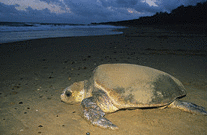

One of the most interesting natural reproductive events is the hatching of sea turtles. Most of us have seen articles or TV documentaries about how sea turtles reproduce. The females return to the island where they were hatched and lay large clutches of eggs. About 51 days later all the eggs hatch at the same time. It is quite a sight to see dozens of baby turtles suddenly erupt from the sand and dash (at turtle dash speed) to the sea.
 Because they all hatch at once, the chance of some of them surviving is greatly improved. Sea birds, crabs, fish, and raccoons all feed on the baby turtles, but multiple turtles coming from their nests greatly improves the success of some of them reaching the relative safety of the ocean. Until recently there was no good explanation of how all the turtles know the exact minute to escape their eggs, dig to the surface of the sand, and race for the sea.
Because they all hatch at once, the chance of some of them surviving is greatly improved. Sea birds, crabs, fish, and raccoons all feed on the baby turtles, but multiple turtles coming from their nests greatly improves the success of some of them reaching the relative safety of the ocean. Until recently there was no good explanation of how all the turtles know the exact minute to escape their eggs, dig to the surface of the sand, and race for the sea.
Recently biologists studying leatherback sea turtles in Oaxaca, Mexico, found the answer. It turns out that baby turtles communicate with each other. More than 300 different sounds have been identified, many of them at very low frequencies. Recording equipment has shown that the baby turtles ears develop after 51 days of incubation and their ability to produce sounds occurs at the same time.
The baby turtles not only synchronize their time of hatching and run together to the sea, but they continue to communicate, so they migrate in groups once they are in the ocean. The turtles are designed to synchronize their early life, giving them the greatest chance to avoiding being eaten. All living things are designed to survive in a world of predation, and yet their numbers do not exceed the available food supply. Designs like the sea turtle abound in the natural world, and we are challenged to know there is a God through the things he has made (Romans 1:20). The more we study living things, the more we realize how easy it is to see God’s hand in the design of life. Source: National Wildlife, Spring 2015, page 10.
Picture credits:
© Nosnibor137. Image from BigStock.com.
